EXPOSOMES SINGULIERS // CNRS

TECHNICAL SPECIFICATIONS
_/ Generative Installation
_/ Dimension : Multi // min 1920px X 1080px
_/ Ratio Multi-ratio (original 9:16)
_/ 30fps-60fps
_/Stereo Sound
EXHIBITIONS
2024
_/CUBE Garges, Néo-Matérialité
EXPOSOMES SINGULIERS
Révéler l'invisible
In collaboration with researchers Francesca Merlin and Thomas Bonnin, Milkorva has devised a computer-generated, hypnotic visual choreography. This work explores the contemporary science and digital tools' ability to decode our individual trajectories through the prism of the exposome, a scientific concept developed around the turn of the 21st century. The exposome examines all the factors we encounter throughout our lives, attempting to understand the repercussions of these exposures on our health. This participatory experience allows spectators to metaphorically visualize the implications of their own exposome on their health.
The installation "Singular Exposomes: Revealing the Invisible" was created following an artistic residency organized in collaboration between Le Cube Garges and the French National Centre for Scientific Research (CNRS) and funded by the National Research Agency (ANR).
Extended gratitude to all the people involved and who made this project possible:
- Francesca Merlin and Thomas Bonin - Researchers at CRNS
- Gareth Dys - Creative coder
- Valentin Fayaud - Sound composer
- Clément Thibault, Anstasiia Baryshnikova, and Maxime Gayno from Cube Garges.
The immersive installation initially invites participants to anonymously fill out a form consisting of 15 questions. The collected data then serves as the basis for the creation of a real-time generative visual composed of millions of constantly evolving particles. Each participant receives a unique number (identifier) at the end of the questionnaire, allowing them to refer to the generated visual. A central button in front of the creation enables them to select their number to contemplate their personalized artwork.
Pedagogical supports composed of informative texts and graphics, suspended on either side of the screen, explain how the artwork was produced and how the visitor's responses influenced the creation. Over the course of the exhibition, dozens of visuals previously generated by participants will be printed and displayed next to the installation, highlighting the individual variability of the exposome. The link between the generated visual and the questionnaire responses prompts reflection centered on the individual regarding the alteration of their exposome through their lifestyle "choices or ways of life". Analyzing the multitude of results obtained makes it possible to identify similarities and differences between visuals, drawing parallels with decisions made during the form.
The collaboration between CNRS researchers and Milkorva took several forms. Initially, research work was conducted to define the most relevant questions to ask in the questionnaire to popularize and profile the exposome, ensuring the scientific accuracy of the collected data. Subsequently, researchers and the artist had to define the connections between form responses and their impact on various parameters of the particle system, such as their movement, velocity, colors, etc. This phase establishes a bridge between the world of science and the realm of digital art, as well as between representation and abstraction.
The concept is to conceive the entire creation as a constantly evolving microorganism, governed by a hierarchy in the classification of elements (color, velocity, particle shape) and by constraints (intensity, amplitude) that compose it. "SINGULAR EXPOSOMES" aims to inspire reflection and raise awareness about the importance of the environment on our health and evolution, while celebrating the creative fusion that can emerge between art and science.
Is this not real ? // PERFORMANCE












